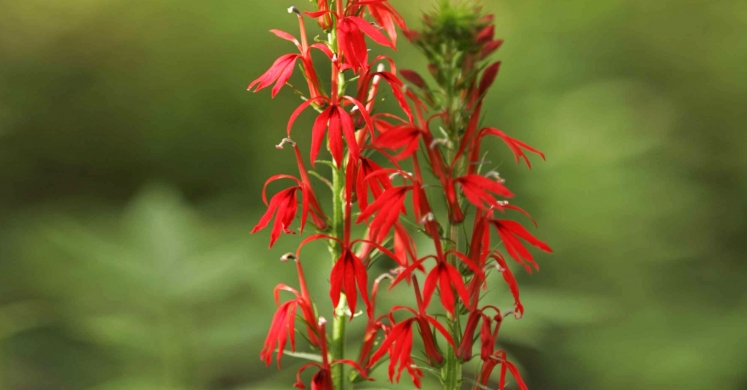Blog

#bioPGH Blog: Cardinal Flower
 A resource of Biophilia: Pittsburgh, #bioPGH is a weekly blog and social media series that aims to encourage both children and adults to reconnect with nature and enjoy what each of our distinctive seasons has to offer. From the best times to plant seasonal flora and enjoy their peak blooms, to astronomical events and creatures to keep an eye and ear out for, Phipps will keep you in the know with what’s going on in our environment!
A resource of Biophilia: Pittsburgh, #bioPGH is a weekly blog and social media series that aims to encourage both children and adults to reconnect with nature and enjoy what each of our distinctive seasons has to offer. From the best times to plant seasonal flora and enjoy their peak blooms, to astronomical events and creatures to keep an eye and ear out for, Phipps will keep you in the know with what’s going on in our environment!
During these recent dry, sweltering days, many flowering plants haven’t been too happy (except maybe those in the Desert Room at Phipps). One exception is the brilliant ruby-red cardinal flower (Lobelia cardinalis), which you can find in the wetter areas around the Center for Sustainable Landscapes. The cardinal flower is a short-lived perennial native to eastern North America, growing from one to six feet tall with showy, unbranched flowers and blooms from late July through September.
This ordinary-looking flower has a very special trait that it shares with exotic fishes such as the moon wrasse and the clownfish: These organisms are all sequential hermaphrodites, meaning they can switch from one sex to the other! This reproductive strategy is quite common in many plants, and for the cardinal flower, this means that when a flower first opens, it’s in its male phase, producing stamens and pollen, and about five days later, it switches to its female phase, producing stigmas which receive pollen. This strategy is specifically called protandry, where the organism changes from male to female (the reverse is protogyny, changing from female to male).
Throughout much of their range, cardinal flowers are exclusively pollinated by the Ruby-Throated Hummingbird (Archilochus colubris). Cardinal flowers are often visited by butterflies, including several swallowtail species, but the butterflies are considered "nectar thieves," because they feed on nectar without contributing to pollination.
Several Native American tribes used the cardinal flower for a diverse range of medical and ceremonial purposes. The Iroquois created a concentrated mash to treat cramps or an upset stomach. The Delaware used the roots to treat typhoid. Other tribes used the plant ceremonially, to ward off a storm or create a love charm. (Please do not consume this plant, no matter how ill or lovesick you are!)
Recent research suggests that the cardinal flower may have positive therapeutic effects. Lobinaline, the major alkaloid of cardinal flowers, was found to be a potent free radical scavenger, a compound that targets harmful molecules that cause cellular or DNA damage. Alkaloids are a group of naturally-occurring chemical compounds that have a broad range of pharmacological benefits. These range from antimalarial treatments (quinine) to analgesics (morphine) and many more. Whether the alkaloid in cardinal flowers will lead to medical advancements is still unclear, but it’s encouraging to know that these native plants may benefit human health in the future!
Connecting to the Outdoors Tip: The cardinal flower can be found around the Center for Sustainable Landscapes and is a local, sustainable plant that you can include in your home garden (it was listed as a Phipps Top 10 Sustainable Plant in 2013.) It can be planted in sunny to partly shady areas of the garden, but cardinal flowers do require moist to wet soil. Plants can be propagated from seed and may self-seed in ideal growing conditions. On Sun., July 31, people of all ages can explore river and meadow habitat at Learn Your Land's Duck Hollow and Lower Frick Park Bird and Nature Walk. This is an opportunity to see a wide array of native plant and animal species, and riverine habitats are likely places to find cardinal flowers.
Continue the Conversation: Share your nature discoveries with our community by posting to Twitter and Instagram with hashtag #bioPGH, and R.S.V.P. to attend our next Biophilia: Pittsburgh meeting.
Resources:
Desert Room | Phipps Conservatory and Botanical Gardens
Center for Sustainable Landscapes | Phipps Conservatory and Botanical Gardens
Novel Multifunctional Pharmacology of Lobinaline, the Major Alkaloid from Lobelia Cardinalis | PubMed.gov
Alkaloid | Wikipedia
2013 Top 10 Sustainable Plants | Phipps Conservatory and Botanical Gardens
Cardinal Flower | Cornell University Gardening Guide
Duck Hollow and Lower Frick Park Bird and Nature Walk | Learn Your Land
Select photos © Paul g. Wiegman

